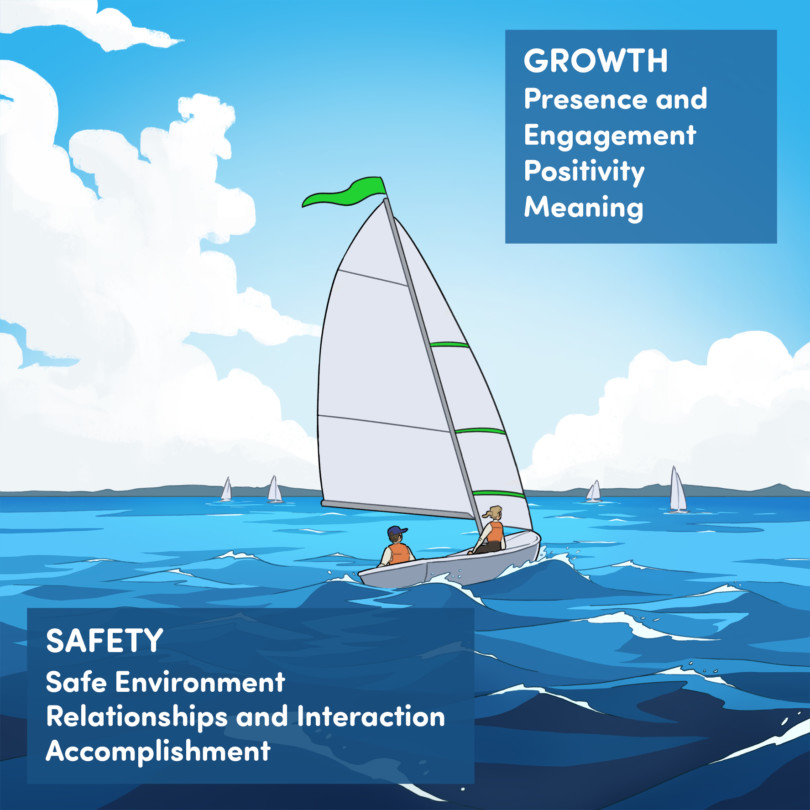Dimensions of Mental Well-being in Sports
Coaches can support the overall well-being of young athletes in childhood and adolescence. The Mental Well-being for Young Athletes methods are based on six important dimensions.
The Mental Well-being for Young Athletesmethods are based on the five dimensions specified by Martin Seligman in his PERMA model of well-being and, in addition, a safe environment. These can be illustrated with a metaphor of a sailboat. By applying the Mental Well-being for Young Athletes methods based on the model, you, as a coach, can promote a feeling of safety and opportunities for growth in coaching.

The five dimensions of the PERMA model of well-being are
- Positive emotions
- Engagement
- Relationships and interaction
- Meaning
- Accomplishment
An Intact Boat is a Safe Boat
Together, a safe environment, positive relationships and experiences of accomplishment provide a solid basis for the activities.
The primary duty of coaches, club personnel,volunteers and other parties involved in sports is to provide a psychologically safe environment for young athletes. This means that the environment must be free of bullying, harassment and inappropriate behaviour and establish a solid basis for growing and developing as an athlete and a human being.
Everyone involved in the activities should be aware of the common ground rules, i.e. what kind of behaviour and consideration of others is expected from them.
Positive relationships, i.e. the support of fellow passengers—especially safe adults—is essential for surviving in storms and shallow waters. Teamwork skills, appreciation of diversity and emotional and interaction skills make the common journey easier.
Experiences of accomplishment contribute to the development of resilience.
These experiences boost the sense of capability, dignity and self-worth, i.e. trust in that you can overcome even the most difficult situations.
Wind in the Sails – Opportunities for Growth
The more strong sails an athlete has available, the more rewarding and pleasant the journey is. Strong sails also help to change the course in an agile and smooth manner whenever the conditions change. These sails are presence and engagement, positivity and meaning.
Young athletes should learn how to focus on systematic training, calm themselves in stressful situations and live in the moment.
The better these presence and engagement skills are mastered, the more often the athlete can enjoy well-being and meaningful life by experiencing a flow state—a feeling when the wind really catches the sail and everything seems to come naturally.
The second strong sail is formed by positivity and the ability to enjoy happy moments: the ability to feel and express gratitude and strengthen positive emotions.
The third sail is meaning, i.e. the experience of having a clear direction for one’s own activities.
Meaning is strongly present in the lives of young athletes when they can apply and develop their core strengths and have a say in their own training. Meaning also provides the strength to keep on trying when faced with difficulties and to come back even stronger after a setback.
Videos about Dimensions of Mental Well-being
Each of the six dimensions of mental well-being is illustrated in a 4–6 minute video that can be found on the MIELI Mental Health Finland YouTube account. You can select text in English in videosettings.
Coach: Start with Small Steps
You can start with small, everyday steps in supporting the mental well-being of a young athlete. Typically, being interested and present is enough.
- Asking questions and addressing the matter indicate that you care and increase the feeling of safety.
- Being heard and personal attention are important to the athlete.
Dimensions of Mental Well-Being Checklist
Apply the PERMA model of well-being as a checklist for training and the season plan.
- Do the athletes I coach have a safe training environment? Do they know what kind of behaviour and consideration of others is expected from them?
- Am I a safe adult with whom it is easy to discuss and share worries? Do the athletes I coach know how to work as a team while understanding and appreciating diversity?
- Do I strengthen the experiences of accomplishment and sense of capability of the athletes I coach through positive feedback, support and encouragement?
- Can the athletes I coach achieve a flow state and enjoy experiences of learning in training? Do I support engagement into training through well-planned exercises and avoiding unnecessary interruptions?
- Do I show the athletes I coach appreciation and gratitude for the joint activities? Do we know how to make good performances visible and boost positive thinking and self-compassion together?
- Do the athletes I coach have a clear understanding of our shared goals? Do they have the opportunity to apply their strengths and have a say in the decisions that affect them?
Additional reading
Kaufman, Scott (2020): Transcend – The New Science of Self-Actualization.
Seligman, Martin (2011): Flourish – A Visionary New Understanding of Happiness and Well-being.
Avola, Pauliina & Viivi Pentikäinen (2019): Kukoistava kasvatus – Positiivisen pedagogiikan ja laaja-alaisen hyvinvointiopetuksen käsikirja.
Csikszentmihalyi, Mihaly (2005): Flow: The Psychology of Optimal Experience.
Rovio, Esa, Taru Lintunen & Olli Salmi (eds.) (2009): Ryhmäilmiöt liikunnassa.
Dweck, Carol (2017): Mindset – Updated edition: Changing The Way You think To Fulfil Your Potential.
Forsblom, Kim (2020): Collective goals and goal setting during a competitive season in women’s national league sport teams.
Tur-Porcar, Ana & Domingo Ribeiro-Soriano (2020): The Role of Emotions and Motivations in Sport Organizations. Frontiers in Psychology 11 May 2020.
Finnish Olympic Committee, sustainability (in Finnish)